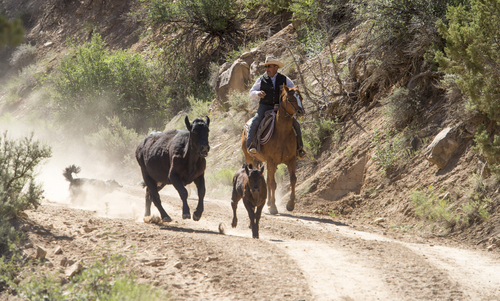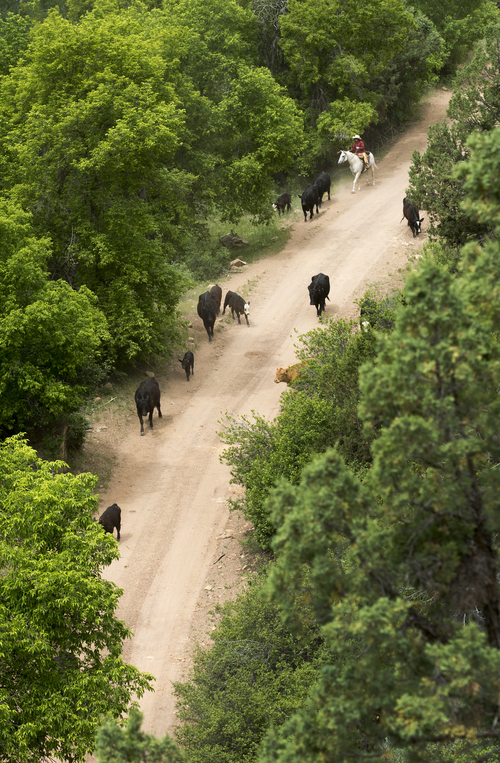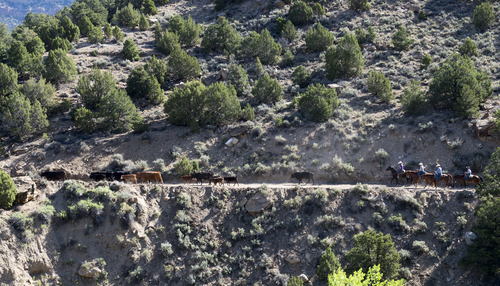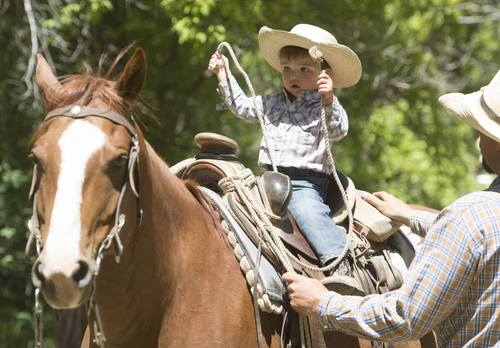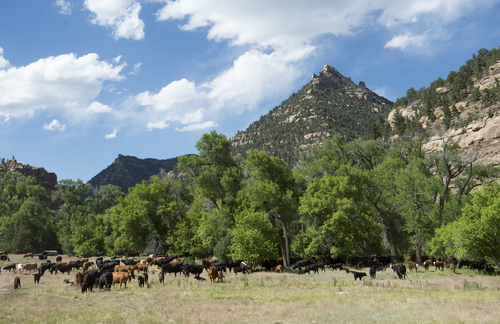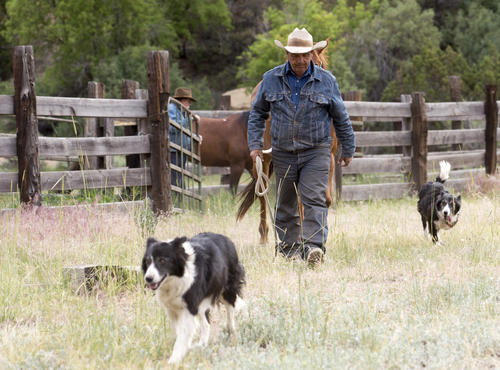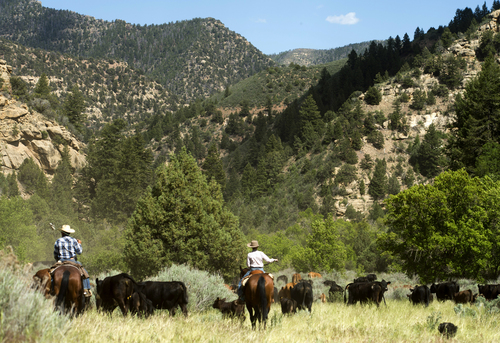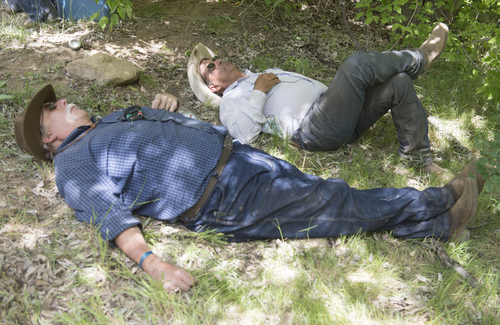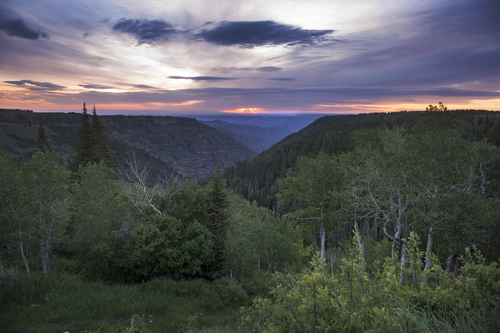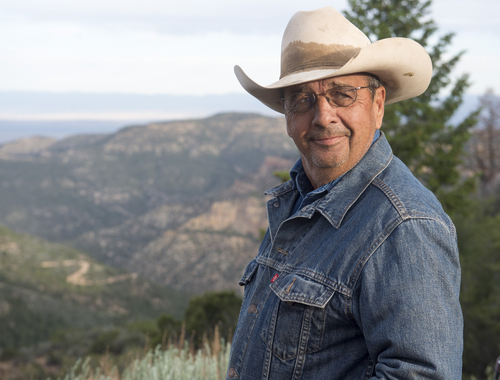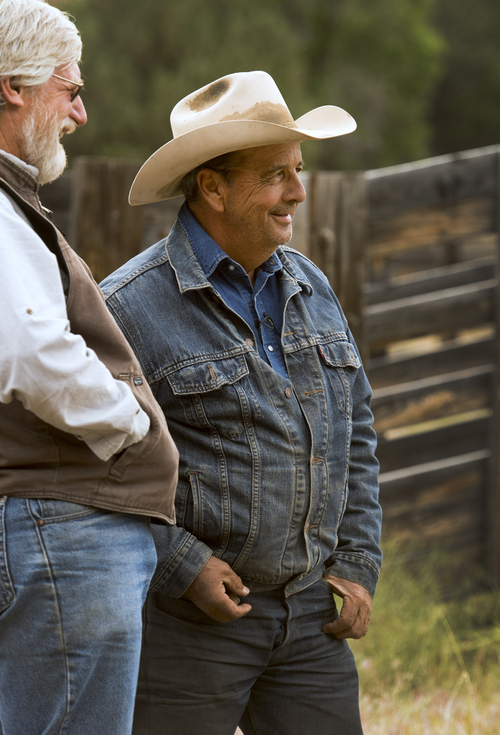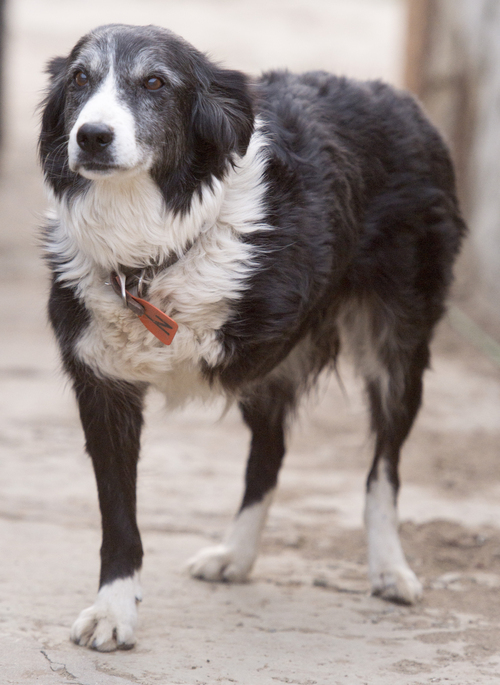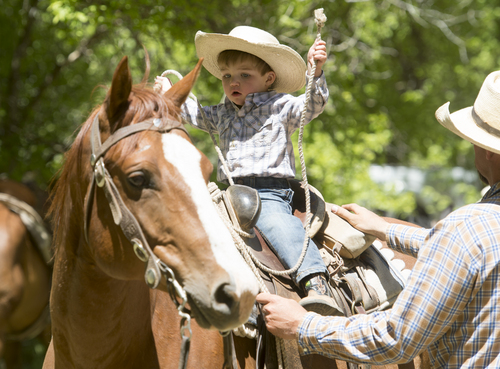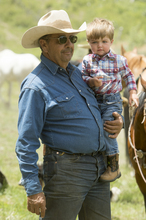This is an archived article that was published on sltrib.com in 2014, and information in the article may be outdated. It is provided only for personal research purposes and may not be reprinted.
Book Cliffs • Jeff Christensen has heard the phrase "the simple life" used to describe his sunrise-to-sunset profession.
He isn't sure whether to take it as an insult or a compliment.
"If you are talking about it like it is not hard work that is definitely not the case," said Christensen, a lifelong rancher now part of the Jensen family working the Tavaputs Ranch. "I guess you could call it simple in that we know there is always something to do, from day to day to day."
Simple life, hard work or both, visitors who experience the ranch routines Christensen, his wife, Jennie, and their two young sons enjoy often want more.
Steve and Gail Eslinger travel twice a year from Tennessee to the Tavaputs Ranch managed by Jennie's parents, Butch and Jeanie Jensen, to help in the spring and fall cattle drives.
"We just hope we don't get in the way," Steve Eslinger said this spring after the cattle had been moved to the high country on Tavaputs Plateau land owned by the Jensens.
Such "weekend help," as Butch Jensen calls friends who join hired hands and family during the twice-yearly roundups, are an important part of the four-day and more than 20-mile drive.
The Tavaputs herd — comprised of roughly 350 head of Angus, Gelbvieh, Brahma and even a few longhorn — spends winters on Bureau of Land Management desert lands in the wide-open flats east and west of Highway 6 between Price and Interstate 70. Come mid-June, the Jensens start gathering the herd and corralling it at the mouth of Horse Canyon on the Carbon and Emery county line.
Then the real work starts. Over three days, cowboys and cowgirls chase, prod and yell at the cows, calves and bulls to get "a move on" up Horse Canyon, onto Little Horse Canyon, then to a well-deserved overnight stop at Range Creek before they complete a final heinous climb up Sheep Canyon and its 10 switchbacks to the plateau.
By then, the cattle and horses have climbed more than 2,000 feet in elevation from the desert to the high mountain meadows.
"You can't truck cattle in this kind of country," Butch Jensen said. "We need all the help we can get keeping them on the road and from falling off a cliff. There are a lot of places along the way they can get lost."
This most recent cattle drive was "at least" the 61st for the 62-year-old. The roundups mark the changing seasons in the ranching world.
—
'Why we are here' • Many of the cattle, particularly the Brahmas, are familiar with the spring routine and know the luscious grassy rewards that await them on the plateau. The Jensens say the Brahmas are an important part "of the team" because they lead the way and pull the other cattle along the trail.
The Jensens and Christensens also look forward to summer on the Tavaputs.
According to the Jensens, Tavaputs translates from its Ute origin as sunrise. Few landscapes in Utah provide sunrises equal to those on the Tavaputs.
"It's like watching a dragon wake up," said Salt Lake Tribune columnist Robert Kirby, who was participating in his 10th cattle drive with the Jensens this spring. "The canyons and everything just fill with light."
It's a sight the Jensens and Christensens look forward to all winter, and one their families have seen many times through the years.
Jeanie Jensen's great-grandparents, the Wilcox family, started ranching on the east side of the Green River in nearby Desolation Canyon in 1887. They eventually sold the land along the Green to the Ute Indian Tribe and bought property on the Tavaputs Plateau. In 1951, the family picked up the Range Creek Canyon property that would eventually become known across the world as an archaeological treasure.
Jeanie Jensen grew up in Range Creek Canyon. Today, she leads Tavaputs Ranch visitors on tours there. Hiking and wildlife watching are also popular on the Tavaputs; hunters fill the lodge each fall in pursuit of trophy elk and mule deer.
The Jensens, her husband's family, has been ranching on the Tavaputs since 1939.
"We were neighbors six miles apart. We rode stick horses together as kids," Jeanie Jensen said of her husband. "It turned out to be a match made in heaven."
Her daughter and son-in-law relish the time they get to spend every day with their boys, 2-year-old Jax and Jet, who was born in March.
"They are with us no matter if we are branding, working on the corral, herding cattle or hauling salt on the desert," Jeff Christensen said. "One of the best parts of my job every day is taking the boys with me. It really is kind of why we are here. Butch said it best: 'This is not ours; it is for our future generations.' We just need to make sure and take care of it so they can have it."
Jax and Jet each had their own cattle brands before they were even born.
"The state told us they had never registered a brand to an unborn baby," Jeanie Jensen said. The brands were instead registered in their mother's name until they arrived.
Cattle bearing the brands of both young boys are already mixed in with the Tavaputs herd.
—
'We could be at the ranch' • Riding as part of a working ranch, in gorgeous country with people they enjoy, draws Steve and Gail Eslinger back to the Book Cliffs twice a year.
"Steve won't even stop to look at other places along the way when we drive out," Gail Eslinger said. "He says it is time we could be at the ranch."
Their son has been traveling to hunt on the ranch for years, coming home with stories of the beauty of the land and his affection for the Jensens. He suggested his parents might want to ride horses in such a setting.
"They don't take a lot of visitors [for the roundup]. Working cows is serious business," Gail Eslinger said. "Our first year we came as guests and the last three times we have come as cowboys and cowgirls."
They cherish their connection to the ranch.
"This is not a dude ranch deal," Steve Eslinger said. "The family history goes back so far and to be able to do something that is not make-believe is special. They are doing this for a living. To be able to be a part of that is just awesome."
Jeff Christensen finds it inspiring that what he does every day is sought after by others.
"I don't think you ever really know exactly what you have. This is how we grew up and we don't know anything else," he said. "It is a pretty good feeling to know that other people want to do it so much."
brettp@sltrib.com Twitter: @BrettPrettyman —
The Utah Bucket List
O Check out the bucket list's Facebook page — facebook.com/UtahBucketList — or follow @UtahBucketList on Twitter and tell us what's on your list of things to do in this life. "Utah's Bucket List 2," a collaboration between The Salt Lake Tribune and KUED-Channel 7, will air Aug. 11 at 7 p.m. —
Dude ranches in Utah
There are plenty of ranches in Utah where guests can help with the work. Some more authentic than others; several include spa treatments — what would past cowhands say about that? The Utah Office of Tourism offers a list of 15 Utah dude ranches at http://www.visitutah.com/hotels-lodging/dude-ranches.
Guests to the remote Tavaputs Ranch on Utah's Book Cliffs enjoy hiking, wildlife watching and tours of the nearby archaeological treasures of Range Creek. Learn more at http://www.tavaputsranch.com.



